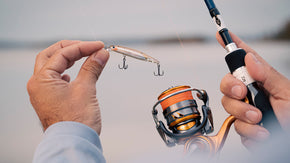Posted 06th December 2024
Structure Fishing Sydney Harbour


By Abz Meshlawi
Sydney Harbour offers an incredible variety of fishing opportunities. With both natural and man-made structures throughout the harbour, it’s a prime location for anglers looking to test their skills and catch a range of species. These structures hold an abundance of fish that are drawn to the food sources in the area. From popular species like bream, trevally, and luderick to larger, harder fighting fish like kingfish, salmon, and mulloway, the harbor provides a chance to catch something exciting every time you cast out. The wide range of the species alone makes structure fishing here a great experience for anglers of all skill levels, and there’s always something new to discover as you explore different parts of the harbour.
What Makes Structures So Appealing to Fish?
Structures around Sydney Harbour offer shelter and attract an array of food sources that draw in fish from all over. In these areas, you’ll find oysters and mussels clinging to the sides of pylons, green weed and crabs both in and around the rocky wash. Small baitfish also gather around these structures, using them as a refuge from predators. Each of these food sources creates a complex ecosystem that supports various fish species. Fishing near structures like bridges, pontoons, jetties, rocky outcrops, mangroves, and boat hulls means you’re tapping into these hotspots of activity. For anglers, that means there’s almost always a fish lurking nearby, waiting to be caught. Understanding the appeal of these food sources can be the key to knowing where and how to fish effectively.

Shallow vs. Deep Structure: Which Is Better?
One of the unique aspects of Sydney Harbour is the variety of structures it offers, ranging from shallow to deep water. This diversity gives anglers plenty of options to explore and adapt based on the season and fish behaviour. Personally, I prefer deeper structures, especially during the colder months when fish like bream tend to stay in deeper waters. Fishing in these areas provides a larger territory to work your lures, and you can often find fish holding in layers throughout the water column. However, as the temperatures rise, it’s common to see bream and other species moving up to shallower waters, feeding on the surface. When you spot them feeding up top, it adds an extra level of excitement as you can visually track your target. For anglers looking for versatility, the combination of shallow and deep structures means you can experiment with different depths until you find where the fish are biting.
In deeper areas, it’s essential to consider the effects of water movement. When currents flow through or around a structure, they often create back eddies on the opposite side. These areas serve as perfect ambush spots for predatory fish, which lie in wait for baitfish to be swept by. By targeting these back eddies, you increase your chances of connecting with more aggressive fish that are ready to strike. Whether you’re exploring the bridges and mangroves upstream or casting along the rugged, washy edges, these ambush points can often hold your next big catch.
Selecting the Right Lures for Structure Fishing
Choosing the right lure is one of the most important aspects of structure fishing. Not all lures are suited for every structure type, so I like to have a few favourites on hand. My go-to lures include the Bait Junkie Risky Critter, Infeet Slippery Dog, and the Infeet Spike. Each of these lures offers specific advantages depending on the conditions and the type of structure I’m fishing.
The Bait Junkie Risky Critter is a fantastic soft plastic lure, especially effective around structures where small crustaceans and baitfish are present. Its natural movement and profile make it a great choice for mimicking the local prey that fish expect to see.
The Slippery Dog, a topwater lure, is my go-to on warmer days when fish are more likely to be feeding near the surface. It creates an exciting visual experience that is like no other.
Lastly, the Infeet Spike 44 is highly versatile, making it effective around different types of structures and ideal for exploring new spots. By rotating through these lures, I can cover various scenarios and maximize my chances of success.

The Importance of Casting Accuracy
When it comes to structure fishing, casting accuracy can make or break your day. Many fish, particularly larger ones, will hold extremely close to the structure itself, sometimes within inches. The closer you can place your lure to the structure, the higher your chances of enticing a strike. However, precise casting requires practice and a steady hand. Spend time refining your casting skills to ensure you’re landing your lure right where it needs to be. This is particularly important when dealing with snag-prone areas, where even a few inches off target can mean the difference between a strike and getting snagged.
Pro Tip: Practice casting towards structure as much as possible. The more you work on your accuracy, the more you’ll notice an improvement in your catch rate. Over time, you’ll find it becomes second nature to place your lure exactly where it needs to go.
Choosing the Right Gear: Rod, Reel, and Line
Selecting the right rod, reel, and line is crucial when fishing structure. You need a setup that provides enough stopping power to control the fish and prevent it from diving back into cover, which could result in a bust-off. For this reason, I prefer using the Daiwa 6lb X-Link fluorocarbon line, as it offers a good balance of strength and stealth. On tougher days, when fish seem more wary, I might downsize to a 5lb line to encourage more bites.
















